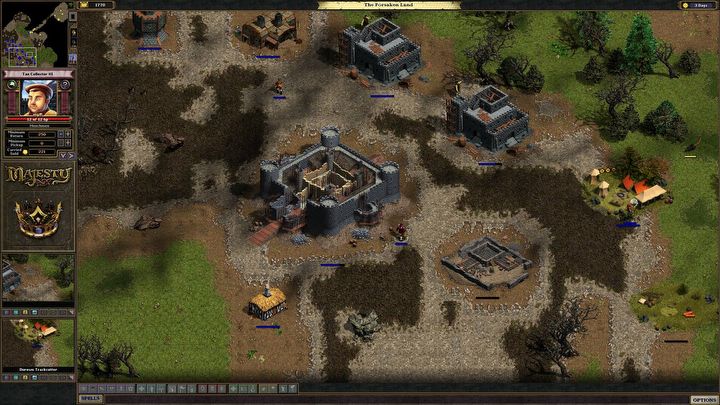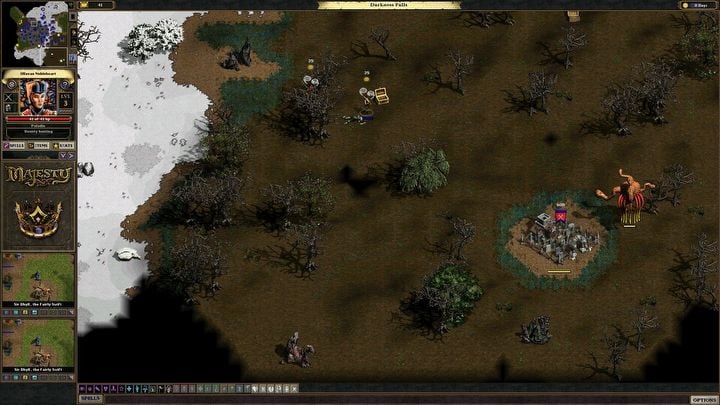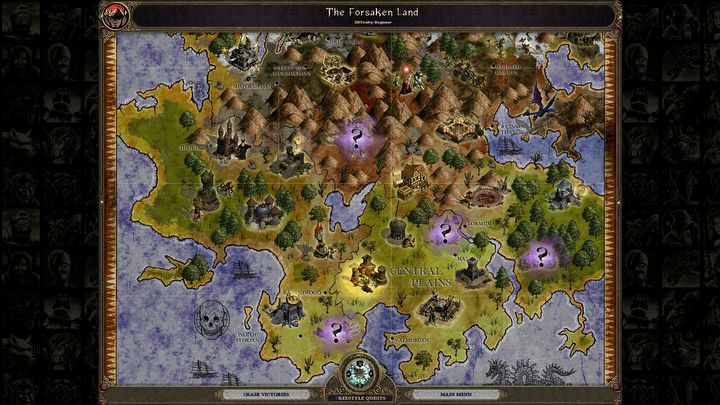
That one game from my childhood, Majesty: The Fantasy Kingdom Sim, has a special place in my heart. Approximately two decades ago, when I first ventured into the world of video games, my brother and I stumbled upon an old CD that belonged to our uncle. Intrigued by the dragon on its cover, we borrowed it and were instantly captivated.
Initially, I found the title of Majesty intriguing. Coincidentally, during that same period, I encountered other games like Chicken Shoot, Duck Hunt, Batman: The Video Game from 1989, and the classic Super Mario Bros. Since I owned a NES back then, I enjoyed my time with it immensely.
However, as I prepared to delve into Fantasy Kingdom Sim, I set aside the “duck gun” in the corner to focus on constructing an ideal castle. Every now and then, I was disturbed by the pesky Ratmen and Url Shekk.
RTS, but not quite
To provide a brief introduction before delving into what drew me to this game for hours on end, let’s discuss its basic premise. Released in 2000 by Cyberlore Studios, the game in question is called Majesty. In this title, we assume the role of a ruler governing the land of Ardania. This game belongs to the real-time strategy (RTS) genre, but with an unusual twist – we have minimal control over our units.
Every journey in Ardania commences similarly: picking one out of the 19 scenarios on our map, followed by a brief narration setting the scene. As a young player of Majesty, I didn’t always grasp the game’s underlying principles. However, I was aware that I needed to construct various structures and attract diverse fantasy characters, such as knights, paladins, mages, elves, gnomes, barbarians, and followers of the sun god. In all, we had approximately 30 buildings at our disposal, along with several hero classes to choose from.

I’m melting!
In the game Majesty: The Forsaken Land, I learned the fundamental mechanics. They weren’t complex at all; essentially, we focused on managing our treasury and enhancing our heroes. To achieve this, we needed to construct suitable structures and recruit soldiers, or “units.” For example, if we ordered the construction of a warrior guild, once it was completed, we hired valiant warriors. However, unlike in some games where you can directly control these warriors, move them to a specific location, and order them to fight a fearsome minotaur or explore areas on the map, this wasn’t possible here. Instead, we relied on their autonomous actions.
In this game, we were given two kinds of flags, each serving a unique purpose. One flag unveiled the map at our chosen location, while the other marked targets for elimination. We planted a flag where it piqued our curiosity, decided on the bounty, and eagerly awaited someone brave enough to collect it. It was essential not to overdo the bounty, as that could lure every hero, regardless of their skill level, into a dangerous situation, causing some to perish (“I’m melting!”). Conversely, if the reward was too meager, no one felt motivated enough to venture out.
The essential goal was to create an environment where our heroes could advance and in doing so, consistently deposit gold into the royal coffers. This objective was primarily achieved through structures like markets, blacksmiths, or inns. I’ve always prioritized building a market and funding research there, offering my people the opportunity to purchase healing potions or teleportation amulets. Typically, when a character went to buy a potion, they would often leave gold from monster slaying at the market.
Later on, a royal tax inspector made an appearance, amassing gold and transporting it back to the castle. Given his sluggish pace (though his elaborate purple cloak could have been the culprit; it’s unclear), there were always monsters menacing at the city borders, biding their time for him. I attempted to mitigate this issue by increasing the number of watchtowers, but the escalating expenses of these structures – including all other buildings – were mounting rapidly.

These damn demons
I found the challenge of the task at hand quite manageable, but I truly thrived when it came to the advanced and expert levels. Perhaps this is why I excel in demanding games – one can never tell! Majesty was particularly adept at providing a tough test, especially when it came to the level of challenge. At its lowest difficulty setting, the gradual growth of the economy and the rise of heroes seemed almost automatic. However, selecting scenarios from the northern parts of Ardania proved quite vexing for me.
At age seven, the challenge called “A Deal with a Demon“, aimed at earning one hundred thousand gold within 40 days, was beyond my capabilities. It wasn’t until years later, once I had grasped the game’s rules more thoroughly, that I managed to finish this mission. Even revisiting Majesty today for a refresher on the mechanics required several tries in certain scenarios.
Absolutely, you can experiment with various tactics such as building a warrior guild and a temple of Dauros. With this setup, we can recruit paladins, my personal favorites, who become invincible at certain levels. These valiant warriors are ready to tackle any quest, even against the most dangerous monsters in Ardania’s depths. Having them on our side often helps me accomplish a mission, provided I can play according to the strategy since objectives sometimes demand specific approaches.

KROLM MAKES ME STRONGER!
Back in 2000 when the game was initially launched, its graphics weren’t particularly impressive. Fast forward a few years, and upon my first playthrough, I didn’t give much thought to the graphics – now I realize they haven’t held up well. The character and building designs seem rather feeble (although there’s a certain appeal, perhaps due to my nostalgia). However, the Majesty Gold HD Edition from 2012 steps in to help, offering some updates to the original game such as improved resolution, two new scenarios, and an official DLC called The Northern Expansion.
One unforgettable aspect of my experience with Majesty is its hauntingly beautiful background music, a memory that lingers long after the game itself has ended. Despite some repetitiveness in the gameplay, the soundtrack stands out as exceptionally well-crafted tunes. The Fantasy Kingdom Sim, too, showcased the unique voices of its characters, particularly the heroes. I bet anyone who’s played this game can still recall the battle cry of Krolm – “Krolm makes me stronger!” – an iconic sound that would resonate when we activated Krolm’s special ability within his temple.
How to play Majesty: The Fantasy Kingdom Sim today?
Currently, both Steam and GOG only offer the Gold HD version of the classic game Majesty for sale, as previously mentioned. On Valve’s platform, it costs $9.99, while on GOG, you can buy it for a slightly lower price at $9.09.
This game, “Majesty: The Fantasy Kingdom Sim“, holds a special place in my heart. Whenever I seek a game to boost my spirits, I often turn to “Majesty“. It’s quite possible that other players share this fondness for the game from their childhood, or perhaps even agree with me about its charm.
Read More
- FARTCOIN PREDICTION. FARTCOIN cryptocurrency
- SUI PREDICTION. SUI cryptocurrency
- Excitement Brews in the Last Epoch Community: What Players Are Looking Forward To
- The Renegades Who Made A Woman Under the Influence
- RIF PREDICTION. RIF cryptocurrency
- Smite 2: Should Crowd Control for Damage Dealers Be Reduced?
- Is This Promotional Stand from Suicide Squad Worth Keeping? Reddit Weighs In!
- Epic Showdown: Persona vs Capcom – Fan Art Brings the Characters to Life
- Persona Music Showdown: Mass Destruction vs. Take Over – The Great Debate!
- “Irritating” Pokemon TCG Pocket mechanic is turning players off the game
2025-01-20 15:02